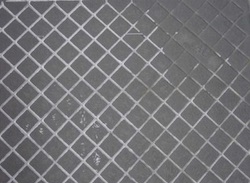Kiln release. What is it? How does it affect tile? Why is it important to address?


If you are a tile contractor, undoubtedly you have encountered kiln release over the course of your career. Noah Chitty, Technical Director for Crossville, Inc., explained that kiln release is a refractory material applied to the back of tiles – often porcelain, but not exclusively – to prevent tile from sticking to the rollers in the kiln. “It theoretically could only cause a problem if there is an excess amount of kiln release,” he said. “Most often – if there is excess – it’s treated like dust and wiped off until there is no more loose powder. Visible, but not loose, kiln release should not cause any concern.”
Why is kiln release even a thing? In a June 2013 article in Aqua News titled “Kiln Release Problems with Engobe,” author Scott Worthington explained that ceramic manufacturers need clay bodies and ceramic glazes to fire quickly – in as little as 45 to 60-minute cycles, which shortens the process from longer kiln times of up to 17 hours. To high fire at 1,200 degrees Celsius on a continuous basis in roller hearth kilns – which transport tiles on rollers through the kiln – chemists needed to develop a range of solutions to ensure the tiles did not stick to the rollers. Two of these solutions include a pressed pattern on the back of tiles that reduces the surface area that comes into contact with the rollers, and “the application of a ceramic coating (alumina-silicate engobe) that is applied to the back of the tile,” Worthington said. This is known as “kiln release.”


This powder can prevent a bond with thin-set mortar if it is not wiped or scrubbed off, but most often it’s fairly easy to remove. Worthington added that surface marking can also be a minor problem – basically, it is loose powder transferred from the back of one tile to the face of the tile packaged underneath it in the box. It is commonly removed during the grouting process, but in rare instances, it remains and produces a “ghosting effect” on the surfaces of the tile still visible after cleaning and unable to be removed. In cases like this, the release has in effect been melted onto the surface of the tile.
Part of the reason this can occur is that magnesium oxide (MgO) has been a common component of kiln release. But if excess kiln release on tiles is subject to moisture, hydration, water, magnesium hydroxide (MgO2) can form and basically fuse to the tile surface. Tiles that are shrink wrapped or packaged in cardboard boxes then stored outside where they are subject to rain and weather are in danger of this happening; cardboard tends to hold water for a longer period of time and create favorable conditions for this chemical reaction. In addition, powder that is left on the tile when installed can in the presence of moisture experience this reaction, which causes pressure to build up and affect the bond between thinset and tile.


Several manufacturers offer products that can help remove kiln release. For instance, using Aqua Mix Heavy Duty Tile and Grout Cleaner before applying Aqua Mix NanoScrub works in 80% of cases to remove this fused release, said another article by Aqua Mix.
But the industry has made attempts to trouble shoot this problem before it happens, by changing the kiln release formula to a slip that is comprised of calcium carbonate and kaolin – the same raw materials as thinset, Chitty said. This more neutral pH mix reduces any concerns with kiln release, especially the etching and marking on the surface of the tiles.
Contractors speak out
In real world circumstances, tile contractors have had various experiences with and methods to address kiln release.


Here’s how NTCA member Metin Gungor of Dekor Construction LLC in Columbus, N.J. has had experience with kiln release:
- Visually inspect and wipe with your hand to see if hand turns white.
- Wash with a wet sponge; observe how clean the tile gets once the dampness dries.
- Scrub to see if it can get cleaner. At this point if it becomes labor intensive, inform customer and get price change.
- If it won’t clean, return product.
Gungor also noted that if engobe is fused to the back of the tile – and now actually part of the ceramic – he considers that suitable for installation. But definitely not if engobe is on the surface of the tile since it renders the tile “visually unacceptable.”


NTCA member Dawn Marie Suiter, owner of Strong Work Renovations of Lafayette, Colo., explained that she recently chose to wash over 100 sq. ft. of large-format porcelain with a stiff bristle brush. “It wasn’t simple or easy, and as I started to do it I second guessed myself and continued to the whole time but, I couldn’t see tile, just kiln release! It seems like it’s getting worse, but my experience isn’t vast and I use cheap tile from a variety of countries.”
The bottom line is that kiln release is a result of the firing process. It’s not uncommon, and can often be simply wiped or washed off before installation. Stubborn kiln release on the tile face may need to be scrubbed off or may require chemical cleansers to remove (which may involve renegotiating price for more labor-intensive processes). Barring success with scrubbing or chemical cleansers, the best route may be to return the product to the store for a new batch of tile altogether.
Editorial Director and Senior Writer for TileLetter and TileLetter ARTISAN
Lesley Goddin has been writing and journaling since her first diary at age 11. Her journey has taken her through a career in publishing and publicity, landing her the editor position of TileLetter and its special publications in 2006. Her goal is to educate, inspire, recognize and encourage those in the tile industry -- especially the tile and stone contractor.








